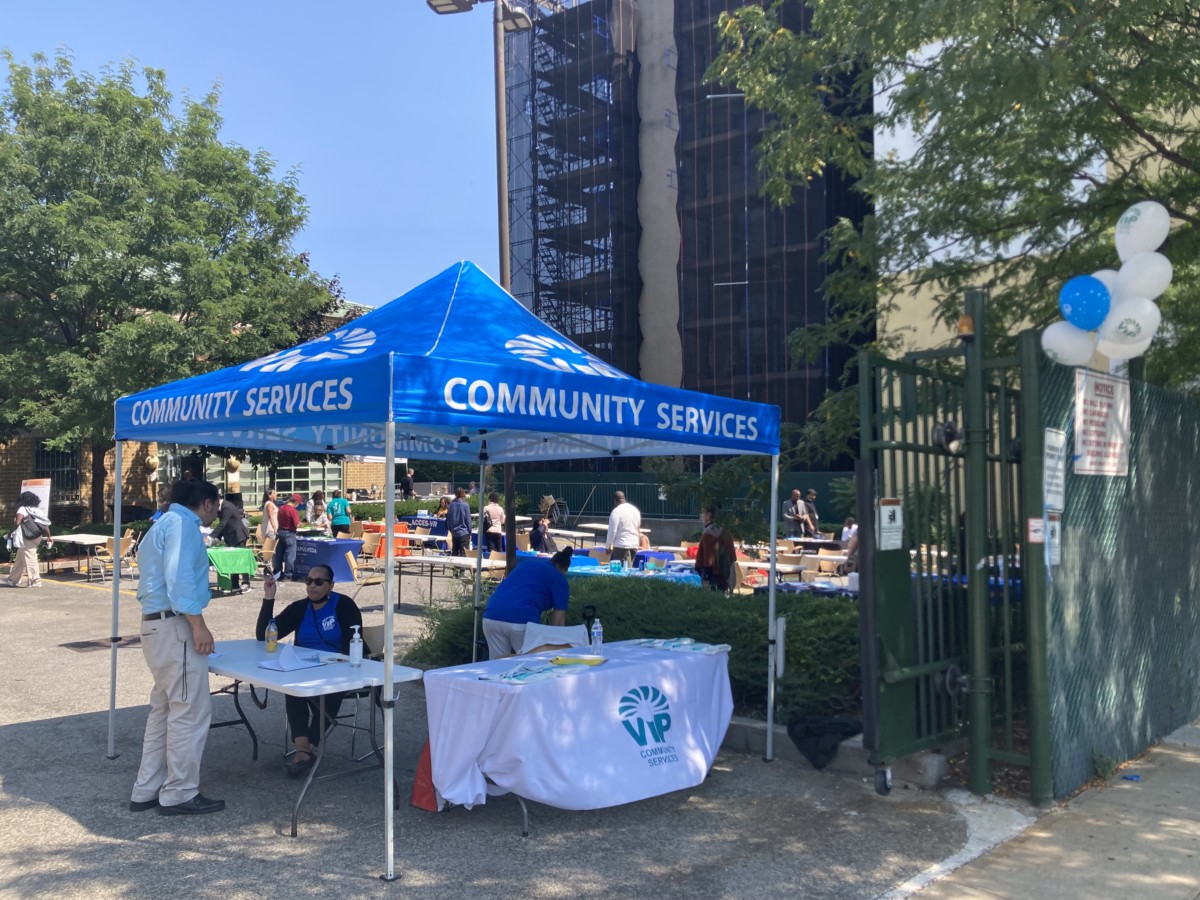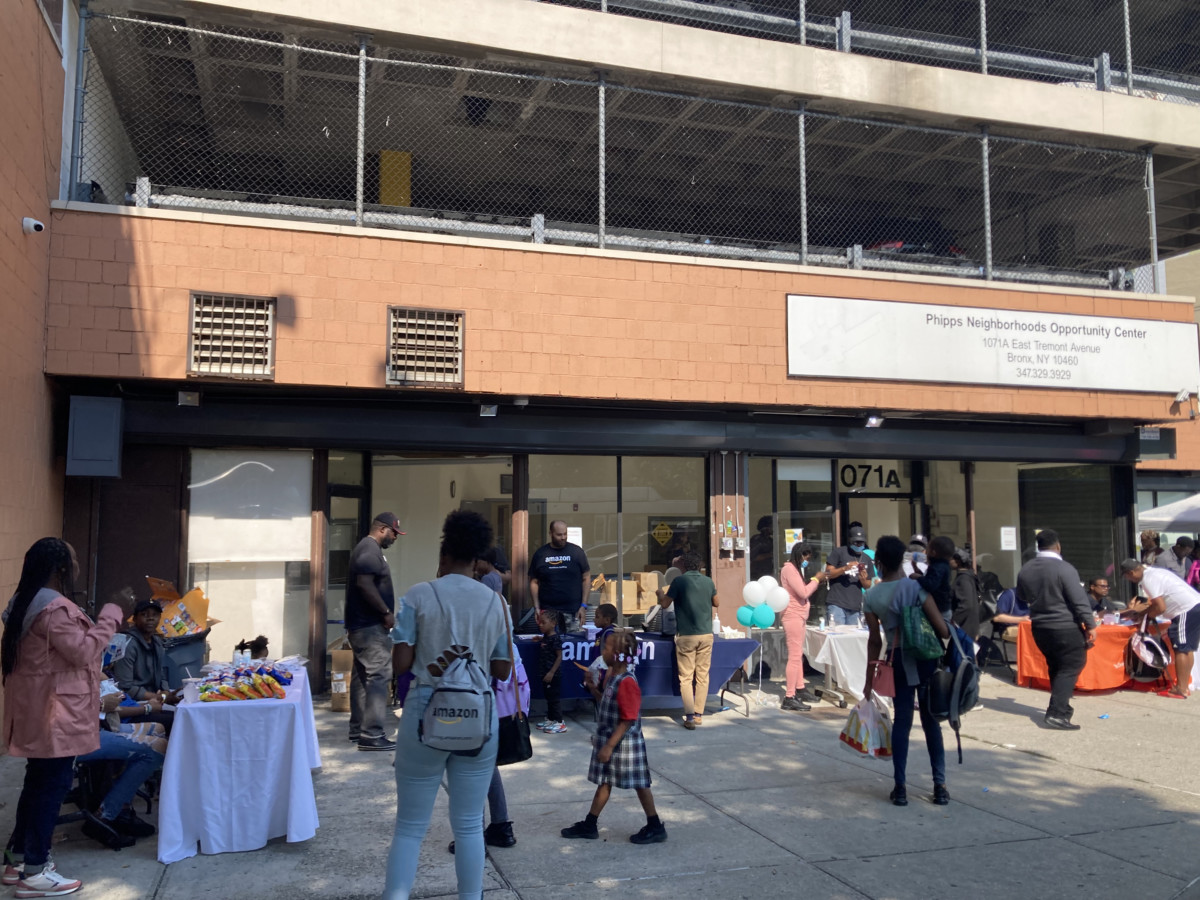Audio slideshow by Nicola Kean and Yardena Schwartz. Text by Yardena Schwartz.
After graduating from culinary school at Manhattan’s Natural Gourmet Institute in July, Bronx-born-and-bred chef Kaci Strother wasted no time getting back to her roots.
At noon earlier this month, the 32-year-old Strother was busy preparing an enticing lunch for more than 1,000 Bronx residents. Hustling back and forth between the cutting board, the oven and the stove, she diced up fresh onions and tomatoes, and mixed a sizzling cauldron of garlic-infused grass-fed beef sauce to accompany a giant batch of whole grain pasta. Dressed in a white apron and lemon yellow turban, Strother was the only lunch lady in the school kitchen not wearing a hair net.
The Urban Assembly School for Wildlife Conservation, a public sixth through ninth grade school, is one of four in the Bronx and 19 in New York City where gourmet chefs have become fixtures in the cafeteria kitchen.
For Urban Assembly and P.S. 67, the elementary school that shares the building on Mohegan Avenue, this means a gourmet chef is cooking lunch every day in a school where 87 percent of students qualify for free lunch.
To meet that standard, a student’s family must receive public assistance or fall under Federal Income Guidelines. According to the advocacy group Citizen’s Committee for Children, 65 percent of families in District 12, where the school is located, earn less than $35,000 a year. In comparison, the citywide average for free lunch qualifiers is 70 percent in elementary schools and 72 in middle schools, according to the non-profit organization Inside Schools.
This “Cook for Kids” initiative, funded by the non-profit New York City organization Wellness in the Schools, is part of a national movement to bring healthier eating habits to children in lower economic areas, where there is less accessibility to healthy food. The short-term goal is to revamp the entire school lunch menu by banishing processed food, incorporating more fresh produce and cooking-from-scratch methods, and teaching healthy cooking classes to students and their parents. The long-term goal is to lower the chances that kids will become obese or develop diabetes, two major threats to the health of Bronx residents.
In the Central Bronx, where the Urban Assembly School resides, more than six in 10 adults are overweight or obese, and 14 percent of Bronx adults have diabetes, according to the city’s Health Department. At this rate, it is estimated that half of all Bronx five-year-olds will develop diabetes in their lifetime. These findings and similar studies have sparked a national movement, most recently spearheaded by First Lady Michelle Obama, to combat the obesity trend as early as possible. By feeding young kids healthier food at school, Strother hopes to attack the problem before it is too late.
“We’re getting them early,” said Strother, who is three months pregnant herself. “There’s no reason a four-year-old can’t say ‘I prefer an apple, not the chips.’ But you have to teach that in a way they can absorb and respect.”
Indeed, this school lunch program is so innovative that it helped to inspire Ms. Obama’s similar initiative, “Chefs Move to Schools,” which she announced this past June as part of her larger “Let’s Move” campaign against childhood obesity. The chef behind the Wellness in the Schools lunch program, Bill Telepan, who operates the upscale New York City restaurant bearing his name, was on the task force to create the First Lady’s initiative. Every two and a half weeks, he visits the kitchens of the 19 schools that are incorporating his recipes and healthier cooking practices.
Wellness in the Schools approached the Urban Assembly School last April to start planning its partnership with the school in West Farms, and Strother began implementing the new lunch menu on Oct. 4. Old staples like mozzarella sticks, french fries, hamburgers and chicken patties have been erased from the menu, replaced by chicken, whole grains, fresh vegetables and fruits, all prepared from scratch.
“It’s so needed, and children are so thirsty for it,” said Strother, stirring her homemade vinaigrette. “Even if there’s resistance at first, it’s so essential to their learning process.” Not surprisingly, there has been push-back from students, whose taste buds have grown fond of and accustomed to less healthy food.
“I think it’s nasty,” said Luis Ruiz, a ninth grader, fiddling his fork over the steamed spinach served with his pasta and meat sauce. Told that his meat sauce was made with grass-fed-beef, Ruiz said, “Now it’s even worse.” He slid his plate a foot down the table, with the look of someone who had just found a maggot in their food. “I don’t even want it anymore. I miss the chocolate milk, the french fries and hamburgers.”
While some students haven’t quite adapted to the healthier lunch menu, opting to skip the meal entirely or bring more familiar options, like Pop Tarts, others acknowledge what is best for them. “I miss the mozzarella sticks and the chicken strips,” said Kyle Farrell, a ninth grader, while he picked on his whole-wheat pasta. “But this is good because it’s more healthy.”
On a recent visit to the school’s kitchen, Telepan was optimistic that more kids would embrace the new lunches eventually. “We know how to make food taste good, and it just turns out it’s healthy,” he said, tasting some of the meat sauce straight from the stove. “We’re not serving them cardboard here.”
As she cooked more spinach and grass-fed-beef for later lunch shifts, Strother was well aware of the steep climb ahead. It will take time to wean children off of processed, high-fat, high-sugar foods. “What they were eating before,” she said, “though not necessarily good for them, was very tasty. We still have some convincing to do, but it will take time. Change doesn’t come easy.”
Nor does it come free. According to Wellness in the Schools, the organization behind the program, the cost of implementing the new lunch plan and teaching the monthly cooking classes that start next month is $30,000 a year. As a small non-profit group, Wellness in the Schools relies on sponsors to fund the initiative, which launched at three other Bronx schools this year. Aside from the Urban Assembly School and P.S. 67, P.S. 53, P.S. 65 and P.S. 140 are also reaping the benefits of healthier lunchrooms. The North Carolina-based charity organization Samara Fund is footing the $30,000 bill for the program at Urban Assembly. The salad company Chop’t pays for the operation at P.S. 65. The Institute for Integrative Nutrition covers the fee for P.S. 53, and P.S. 140 receives the program through its sponsor, Share Our Strength, a national organization that fights hunger.
“There’s a real movement afoot to look at these issues because we need to change this situation,” said Wellness in the Schools co-founder Nancy Easton. And the school cafeteria is the perfect place to start. “School Foods serves 860,000 kids a day,” said Easton, referring to the city’s provider of school food and kitchen staff, the largest school food service in the country. “If we can make a dent there, we could really tip the scales.”
Obesity is not only a danger to children’s health, but also a heavy burden on the American economy. A 2009 study by the medical journal Health Affairs estimated that $147 billion is spent treating obesity-related diseases, such as diabetes, every year. That accounts for almost 10 percent of all medical spending in the country, the study concluded.
“Fast food seems cheaper,” said Strother, “but what you’re not paying here, you will pay in the hospital. So do you want to spend it on your food or on dialysis?” Feeding children healthy meals at school removes the financial barrier low-income families face when it comes to buying fresh, nutritious – and normally more expensive – food.
The new lunch program isn’t the only ambitious health initiative that needy Bronx schools are embracing this school year. Urban Assembly — along with 10 other low-income schools that Wellness in the Schools has partnered with — also participate in the organization’s “Coach for Kids” program. For two hours a day, the organization sends counselors to school recess to encourage more activity. The coaches organize games for the kids, and specifically target children who normally sit on the sidelines. The coaching program costs $10,000 a year and is also sponsored by various donor organizations.
“The ultimate goal is that the next generation of children will not have the same obesity crisis,” said Easton. Urban Assembly is particularly active in its efforts to combat childhood obesity and other health obstacles Bronx children face, such as less accessibility to and affordability of quality produce. Aside from the redesigned lunch menu and the recess coaches, Urban Assembly students also have the option of taking an after-school culinary class in sustainable, healthy, global cooking. The “Healthy Culinary Adventures” class, funded by the New York chapter of the international anti-fast food organization Slow Food, launched on Oct. 5 with 12 students from the ninth grade. The 10-week class teaches students recipes from around the world, complete with lessons on the nutritional values of every recipe ingredient and the climate conditions that nurture those ingredients. The course is taught by the school’s climate change instructor, Alex Rodriguez, and will be offered in three sessions throughout the school year. To increase its appeal to teenage students, the self-proclaimed health nut Rodriguez incorporates an “Iron Chef” style cooking competition into the program.
If child health advocates have any doubt about kids’ enthusiasm for nutritious food, the excitement surrounding the after-school program offers much hope. Asked what part of the class she looks forward to most, 14-year-old Tiffany Miller had trouble singling out one thing. “Learning why some food tastes the way it does and why we’re so addicted to fast food,” she said. “We don’t even know exactly what we’re eating at this point. It will be good to know what we’re putting into our bodies, and to know how to actually cook a meal that’s healthy for us.”
Strother hopes that more kids will get excited about eating healthier lunch food. Many children who at first turned away from vegetables were now starting to love them, she said. Whether they like it or not, she will do whatever it takes to help them lead healthier lives. “Aside from being extremely needed by the schools, parents and the city,” Strother said, taking a break to eat her own school lunch, “it’s also coming from the White House.”









